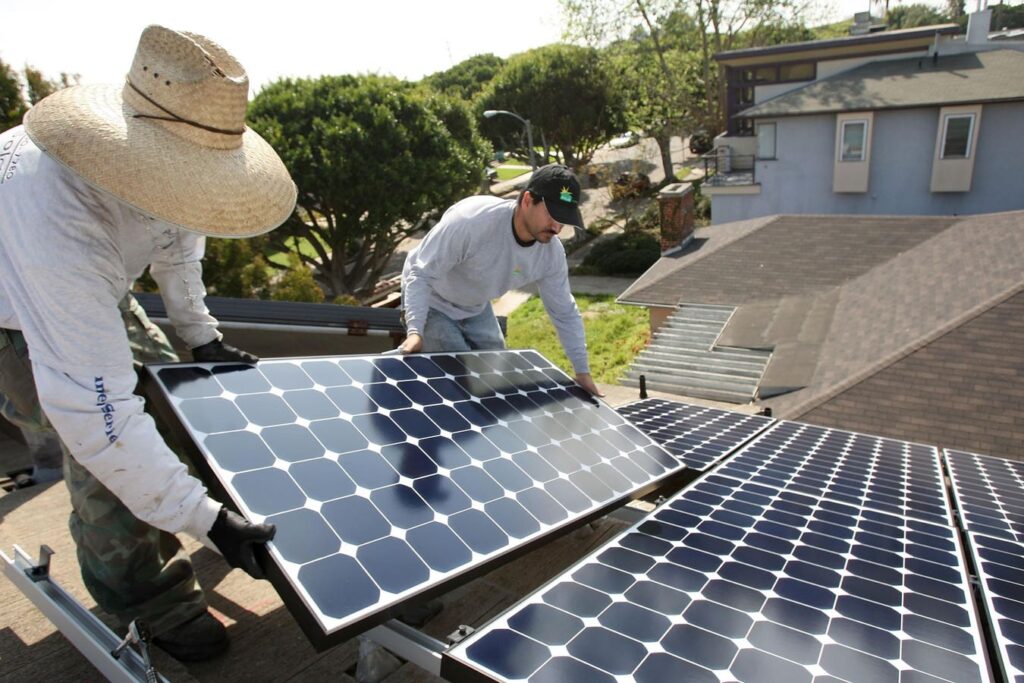With warmer weather heading into spring, your air conditioning is about to make your electricity bill soar and you’re thinking of buying an electric vehicle and installing a charging station for it. Plus you’d like to do your part to combat climate change. So you’re thinking now is maybe the time to get solar panels installed on your roof to cut your electricity costs and help save the planet to boot. But now you need to decide: do you buy your solar panels? Or is it better to lease them? I can help guide you to the choice that is right for you.
A growing trend: Solar accounted for 43% of all new electricity-generating capacity added in the U.S. last year, making it the top technology for the second year in a row. There are now more than 149 gigawatts (GW) of solar capacity installed nationwide, enough to power 26 million homes. The cost to install solar has plummeted by more than half over the last decade. The technology has long been most popular in California but other states, including Texas, Florida, and New York, also saw substantial growth in solar last year.
What does it cost? Solar panels generate free electricity but the cost comes with the installation. The national average cost to buy a home system runs $20,650 after the 30% federal tax credit, according to EnergySage. But the cost varies widely, depending on the size of your home and which state you call home. Switching to solar could reduce your energy bill by as much as 75%; it can take between five and 15 years for the energy savings to make up for the installation costs.
How does the federal tax credit work? The solar investment tax credit allows qualifying property owners to get a tax credit for 30% of the cost to install a solar energy system on their federal taxes for systems installed between 2022 and 2032. The credit gradually drops each year after that and expires in 2035, unless Congress renews it. That provides a dollar – for – dollar reduction in the income tax you would owe. Included in the tax credit are solar panels, contract labor, system equipment such as wiring, batteries, or other energy storage devices, and permits and fees. Visit the Database of State Incentives for Renewables & Efficiency (DSIRE) to see what other incentives may be available in your state and also check with your local government.
Should I leave or buy? Leasing comes with little or no upfront costs but you don’t own the system and a long-term lease can potentially complicate a sale should you decide to move later. It’s worth leasing if the costs to do so are cheaper than your current electricity bill. To get the federal tax credit, you must buy, not lease, your system. If you can afford it, it’s generally better to buy, especially if you plan to stay in your home for at least seven years. A 2019 survey by Zillow found that homes with solar panels sell for about 4% more than similar homes that don’t have solar.
Can I get a loan to buy solar panels? If you can’t afford to lay out the money to buy your system outright, there are several loan options to buy a solar panel system. They include Residential property-assessed clean energy (PACE) loans, Home equity loans, home equity lines of credit, and government loans, such as Fannie Mae’s HomeStyle Energy Program. Some solar companies offer their own financing as well. If you’re buying or refinancing a home, the HomeStyle Energy Mortgage Program and the Federal Housing Administration’s Energy Efficient Mortgage Program can help you install solar panels at the same time. If you decide to sell your home, your purchased system, whether or not there is a loan against it, can be transferred to the new owner. Also, note that you may want to purchase a battery or other kind of energy storage so you still have power if the electricity system fails and to use at night when the sun isn’t generating energy for your home.
How does a lease work? Instead of owning the equipment, you make monthly payments to use the panels’ system for the duration of the lease term. Your leasing company is responsible for maintaining and repairing the solar panel system during this time. When the lease period is up, generally between 20-25 years, you typically have the option to renew the lease, purchase the system at “fair market value” or have the leasing company remove the system from your property. While leasing, you pay a flat monthly fee in exchange for the energy. Check with your insurance company to see if your policy covers leased panels.
What is a Power Purchase Agreement? A PPA is another way to get solar panels installed on your property without paying for them upfront. An energy service company (ESCO) installs the panels, owns and maintains them. You then purchase the electricity generated by the solar panels from the ESCO at a fixed price. Look carefully at any such arrangement as some homeowners say they feel “stuck” if the price keeps going up over time. But if a solar panel installation isn’t right for your property, you may be able to opt for a virtual lease or PPA.
Read the full article here


